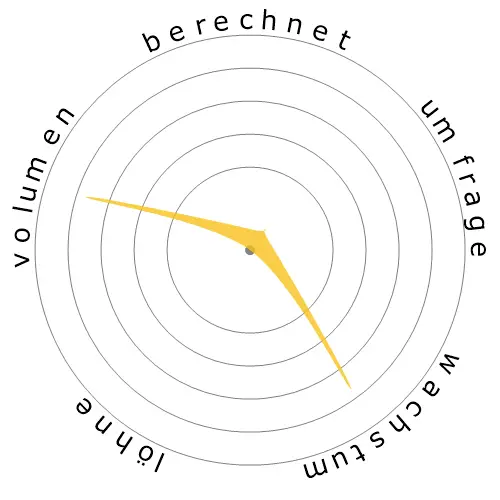Fahrer/Verkaufsmitarbeiter




Personen haben sich auch angesehen
Berechnetes Automatisierungsrisiko
Unmittelbares Risiko (81-100%): Berufe auf dieser Ebene haben eine extrem hohe Wahrscheinlichkeit, in naher Zukunft automatisiert zu werden. Diese Jobs bestehen hauptsächlich aus repetitiven, vorhersehbaren Aufgaben, bei denen nur wenig Bedarf an menschlichem Urteilsvermögen besteht.
Weitere Informationen darüber, was dieser Wert ist und wie er berechnet wird, sind verfügbar hier.
Benutzerumfrage
Unsere Besucher haben abgestimmt, dass es wahrscheinlich ist, dass dieser Beruf automatisiert wird. Diese Einschätzung wird weiterhin durch das berechnete Automatisierungsrisiko unterstützt, welches eine 93% Chance der Automatisierung schätzt.
Was denken Sie, ist das Risiko der Automatisierung?
Wie hoch ist die Wahrscheinlichkeit, dass Fahrer/Verkaufsmitarbeiter in den nächsten 20 Jahren durch Roboter oder künstliche Intelligenz ersetzt wird?
Gefühl
Das folgende Diagramm wird überall dort eingefügt, wo eine beträchtliche Anzahl von Stimmen vorliegt, um aussagekräftige Daten darzustellen. Diese visuellen Darstellungen zeigen die Ergebnisse von Nutzerumfragen im Laufe der Zeit und geben einen wichtigen Hinweis auf Stimmungstrends.
Gefühlslage über die Zeit (jährlich)
Wachstum
Die Anzahl der 'Driver/Sales Workers' Stellenangebote wird voraussichtlich um 9,2% bis 2033 steigen.
Gesamtbeschäftigung und geschätzte Stellenangebote
Aktualisierte Prognosen sind fällig 09-2025.
Löhne
Im Jahr 2023 betrug das mittlere Jahresgehalt für 'Driver/Sales Workers' 35.420 $, oder 17 $ pro Stunde.
'Driver/Sales Workers' wurden 26,3% niedriger bezahlt als der nationale Medianlohn, der bei 48.060 $ lag.
Löhne über die Zeit
Volumen
Ab dem 2023 waren 463.120 Personen als 'Driver/Sales Workers' in den Vereinigten Staaten beschäftigt.
Dies entspricht etwa 0,30% der erwerbstätigen Bevölkerung im ganzen Land.
Anders ausgedrückt, ist etwa 1 von 327 Personen als 'Driver/Sales Workers' beschäftigt.
Stellenbeschreibung
Fahren Sie einen LKW oder ein anderes Fahrzeug auf festgelegten Routen oder innerhalb eines festgelegten Gebiets und verkaufen oder liefern Sie Waren, wie Lebensmittel, einschließlich Restaurant-Take-Away-Artikel, oder holen Sie Artikel ab oder liefern Sie diese, wie gewerbliche Wäsche. Sie können auch Bestellungen aufnehmen, Zahlungen einziehen oder Waren am Lieferpunkt einlagern.
SOC Code: 53-3031.00


Kommentare
I think by 2040, the majority of cars on the road will be driven by AI.
And if you don't need human drivers, then trucks and lorries will not make sense from a business standpoint. So, I think large trucks will disappear and a large truck will be replaced with a fleet of smaller cars driven by AI artificial intelligence algorithms.
letters...
If a drone loses signal...what, hover in place with 500 other stones until the battery runs out, return to base, etc..
If the Earth's GPS coverage reaches 100% confidence over an entire delivery area then yes, automation, UNLESS the delivery is to a condo/apartment/mobile home park/ hotel or any delivery point that exists as one unit among many, all sharing the same street address. If these two issues are solved then yes, automation. If these issues persist it will delay implementation.
In sum, it could go either way.
Sincerely,
Heath Edwards
Multiple addresses in one place would also be handled initially by the human equivalent expedient of dumping the package at the apartment block door or leaving a "we missed you - come collect your package at the depot" postcard... given that the delivery times would probably still be faster there would be as few complaints as now (and it would get blamed on software errors instead of shuffling the human to a different route).
This might improve with new buildings with drone landing pads on the roof with special recepticles might well become the norm, proving safer for the incoming packages as well as not having to go to the depot to collect packages that could not be delivered because you weren't in.
Hinterlassen Sie eine Antwort zu diesem Beruf